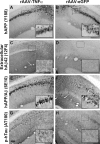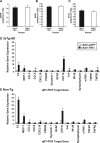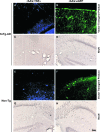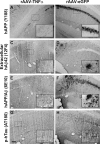Chronic neuron-specific tumor necrosis factor-alpha expression enhances the local inflammatory environment ultimately leading to neuronal death in 3xTg-AD mice
- PMID: 18974297
- PMCID: PMC2626388
- DOI: 10.2353/ajpath.2008.080528
Chronic neuron-specific tumor necrosis factor-alpha expression enhances the local inflammatory environment ultimately leading to neuronal death in 3xTg-AD mice
Abstract
Inflammatory mediators, such as tumor necrosis factor-alpha (TNF-alpha) and interleukin-1beta, appear integral in initiating and/or propagating Alzheimer's disease (AD)-associated pathogenesis. We have previously observed a significant increase in the number of mRNA transcripts encoding the pro-inflammatory cytokine TNF-alpha, which correlated to regionally enhanced microglial activation in the brains of triple transgenic mice (3xTg-AD) before the onset of overt amyloid pathology. In this study, we reveal that neurons serve as significant sources of TNF-alpha in 3xTg-AD mice. To further define the role of neuronally derived TNF-alpha during early AD-like pathology, a recombinant adeno-associated virus vector expressing TNF-alpha was stereotactically delivered to 2-month-old 3xTg-AD mice and non-transgenic control mice to produce sustained focal cytokine expression. At 6 months of age, 3xTg-AD mice exhibited evidence of enhanced intracellular levels of amyloid-beta and hyperphosphorylated tau, as well as microglial activation. At 12 months of age, both TNF receptor II and Jun-related mRNA levels were significantly enhanced, and peripheral cell infiltration and neuronal death were observed in 3xTg-AD mice, but not in non-transgenic mice. These data indicate that a pathological interaction exists between TNF-alpha and the AD-related transgene products in the brains of 3xTg-AD mice. Results presented here suggest that chronic neuronal TNF-alpha expression promotes inflammation and, ultimately, neuronal cell death in this AD mouse model, advocating the development of TNF-alpha-specific agents to subvert AD.
Figures









Similar articles
-
Ablation of TNF-RI/RII expression in Alzheimer's disease mice leads to an unexpected enhancement of pathology: implications for chronic pan-TNF-α suppressive therapeutic strategies in the brain.Am J Pathol. 2011 Oct;179(4):2053-70. doi: 10.1016/j.ajpath.2011.07.001. Epub 2011 Aug 9. Am J Pathol. 2011. PMID: 21835156 Free PMC article.
-
Chronic neuron- and age-selective down-regulation of TNF receptor expression in triple-transgenic Alzheimer disease mice leads to significant modulation of amyloid- and Tau-related pathologies.Am J Pathol. 2013 Jun;182(6):2285-97. doi: 10.1016/j.ajpath.2013.02.030. Epub 2013 Apr 6. Am J Pathol. 2013. PMID: 23567638 Free PMC article.
-
Interferon-{gamma} differentially affects Alzheimer's disease pathologies and induces neurogenesis in triple transgenic-AD mice.Am J Pathol. 2009 Nov;175(5):2076-88. doi: 10.2353/ajpath.2009.090059. Epub 2009 Oct 1. Am J Pathol. 2009. PMID: 19808651 Free PMC article.
-
Effects of CX3CR1 and Fractalkine Chemokines in Amyloid Beta Clearance and p-Tau Accumulation in Alzheimer's Disease (AD) Rodent Models: Is Fractalkine a Systemic Biomarker for AD?Curr Alzheimer Res. 2016;13(4):403-12. doi: 10.2174/1567205013666151116125714. Curr Alzheimer Res. 2016. PMID: 26567742 Review.
-
Alcohol drinking exacerbates neural and behavioral pathology in the 3xTg-AD mouse model of Alzheimer's disease.Int Rev Neurobiol. 2019;148:169-230. doi: 10.1016/bs.irn.2019.10.017. Epub 2019 Oct 23. Int Rev Neurobiol. 2019. PMID: 31733664 Free PMC article. Review.
Cited by
-
Interactions between inflammation, sex steroids, and Alzheimer's disease risk factors.Front Neuroendocrinol. 2016 Oct;43:60-82. doi: 10.1016/j.yfrne.2016.09.001. Epub 2016 Sep 17. Front Neuroendocrinol. 2016. PMID: 27651175 Free PMC article. Review.
-
Astrocytic α2-Na+/K+ ATPase inhibition suppresses astrocyte reactivity and reduces neurodegeneration in a tauopathy mouse model.Sci Transl Med. 2022 Feb 16;14(632):eabm4107. doi: 10.1126/scitranslmed.abm4107. Epub 2022 Feb 16. Sci Transl Med. 2022. PMID: 35171651 Free PMC article.
-
IL-1β-driven amyloid plaque clearance is associated with an expansion of transcriptionally reprogrammed microglia.J Neuroinflammation. 2019 Dec 10;16(1):261. doi: 10.1186/s12974-019-1645-7. J Neuroinflammation. 2019. PMID: 31822279 Free PMC article.
-
Glial contributions to neurodegeneration in tauopathies.Mol Neurodegener. 2017 Jun 29;12(1):50. doi: 10.1186/s13024-017-0192-x. Mol Neurodegener. 2017. PMID: 28662669 Free PMC article. Review.
-
Sustained IL-1β expression impairs adult hippocampal neurogenesis independent of IL-1 signaling in nestin+ neural precursor cells.Brain Behav Immun. 2013 Aug;32:9-18. doi: 10.1016/j.bbi.2013.03.003. Epub 2013 Mar 16. Brain Behav Immun. 2013. PMID: 23510988 Free PMC article.
References
-
- Billings LM, Oddo S, Green KN, McGaugh JL, LaFerla FM. Intraneuronal Abeta causes the onset of early Alzheimer’s disease-related cognitive deficits in transgenic mice. Neuron. 2005;45:675–688. - PubMed
-
- Griffin WS. Inflammation and neurodegenerative diseases. Am J Clin Nutr. 2006;83:470S–474S. - PubMed
-
- Streit WJ. Microglia and Alzheimer’s disease pathogenesis. J Neurosci Res. 2004;77:1–8. - PubMed
-
- Duffy PE, Rapport M, Graf L. Glial fibrillary acidic protein and Alzheimer-type senile dementia. Neurology. 1980;30:778–782. - PubMed
-
- Haga S, Akai K, Ishii T. Demonstration of microglial cells in and around senile (neuritic) plaques in the Alzheimer brain. An immunohistochemical study using a novel monoclonal antibody. Acta Neuropathol. 1989;77:569–575. - PubMed
Publication types
MeSH terms
Substances
Grants and funding
LinkOut - more resources
Full Text Sources
Other Literature Sources
Medical
Molecular Biology Databases
Miscellaneous

